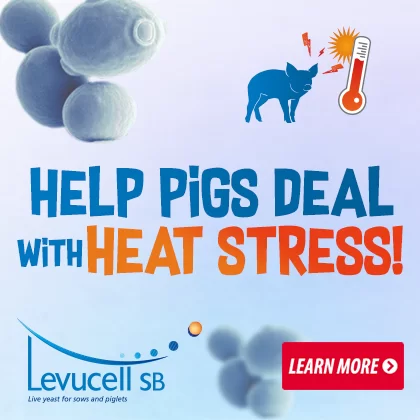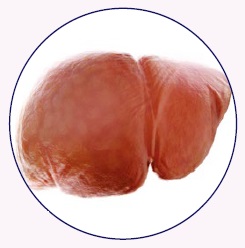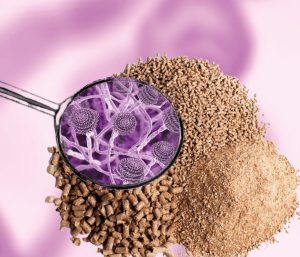Latest Anti-Mycotoxins trends in animal feeding
 Years pass by and mycotoxin control keeps being critical in animal feeding. Anti-mycotoxin research and product development are ongoing topics in the animal feed industry.
Years pass by and mycotoxin control keeps being critical in animal feeding. Anti-mycotoxin research and product development are ongoing topics in the animal feed industry.
Reasons why mycotoxin control cannot be neglected


 Animal Health and Performance: Mycotoxins, such as Aflatoxins, Fumonisins, and Deoxynivalenol (DON), can cause a wide range of health issues, including immunosuppression, liver and kidney damage, reduced feed intake, and impaired growth. Chronic exposure leads to long-term health issues, lower productivity, and higher susceptibility to diseases.
Animal Health and Performance: Mycotoxins, such as Aflatoxins, Fumonisins, and Deoxynivalenol (DON), can cause a wide range of health issues, including immunosuppression, liver and kidney damage, reduced feed intake, and impaired growth. Chronic exposure leads to long-term health issues, lower productivity, and higher susceptibility to diseases.
- Economic Losses: Mycotoxins result in significant financial losses for farmers due to reduced animal productivity, increased veterinary costs, and the need for expensive detoxification strategies. Contaminated feed may also need to be discarded or treated, adding to the costs.
- Food Safety: Mycotoxins can enter the food chain through animal products such as milk, meat, and eggs. Aflatoxin B1, for example, can be converted into Aflatoxin M1 in dairy cows and contaminate milk. Strict regulations are in place to limit mycotoxin levels in both animal feed and food for human consumption to prevent health risks.

- Regulatory Compliance: Many countries have stringent regulations on allowable levels of mycotoxins in feed and food. Exceeding these limits can result in product recalls, legal penalties, and loss of market access, particularly for export-oriented industries.
- Impact on Reproductive Performance: Mycotoxins like Zearalenone mimic estrogen, causing reproductive issues in livestock, especially pigs. This can lead to reduced fertility, miscarriages, and poor offspring development, further impacting farm profitability.
 Thus, effective mycotoxin management ensures healthier animals, better production efficiency, and safer food products.
Thus, effective mycotoxin management ensures healthier animals, better production efficiency, and safer food products.
Today we know that controlling mycotoxins in animal feed requires a multifaceted approach due to the complex nature of contamination. It cannot be achieved by separated actions. The key factors in mycotoxin control are:
- Prevention at the Source: Effective mycotoxin control starts with managing raw materials. This involves using good agricultural practices (GAP) such as crop rotation, controlling humidity and temperature during harvest and storage, and reducing insect damage that promotes mold growth. Monitoring and ensuring feed is stored in dry, well-ventilated environments can prevent mold proliferation.
- Regular Testing and Monitoring: Frequent testing of feed ingredients and finished products for mycotoxin contamination is essential. Rapid testing methods like ELISA and LC-MS/MS are widely used to detect mycotoxins like Aflatoxins, Fumonisins, and Zearalenone. Early detection allows for prompt intervention and prevents contaminated feed from reaching animals.
- Use of Mycotoxin Binders: Adsorbents such as bentonite, zeolite, and activated carbon can bind mycotoxins in the gastrointestinal tract of animals, preventing absorption into the bloodstream. More advanced binders target specific mycotoxins, ensuring broader protection against contamination.
- Detoxification Agents: Enzyme-based solutions and biological detoxifiers are increasingly used to degrade mycotoxins into less harmful compounds.
Enzymes can break down specific mycotoxins such as fumonisins, while probiotic strains like Lactobacillus can reduce mycotoxin impact by modifying their bioavailability.
- Animal Health Monitoring and Biomarkers: Monitoring animal health using biomarkers is an emerging strategy for controlling mycotoxins. Blood-based biomarker testing can detect the biological impact of mycotoxins in animals, helping farmers intervene early and adjust feed management practices.
- Comprehensive Feed Management: Combining the use of binders, regular feed testing, proper storage, and detoxifying additives in an integrated mycotoxin control program can help minimize risks.
This holistic approach ensures that all aspects of feed production and storage are optimized to reduce contamination. Together, these strategies ensure effective control over mycotoxins, improving animal health, feed safety, and farm profitability.
What has been done in the industry to mitigate mycotoxin negative effects?
Recent developments in anti-mycotoxin trends for animal feed focus on enhancing the effectiveness of mycotoxin control and detoxification strategies. A key trend is the use of innovative mycotoxin binders and biotransformation agents.
These products are designed to deactivate a broad spectrum of mycotoxins like Aflatoxins, Trichothecenes, and Zearalenone.
Additionally, natural binders like clay and activated minerals, are becoming more prevalent due to their ability to absorb toxins without impacting nutrient absorption.

Other trends include using yeast cell walls, enzymes, and probiotics that not only bind toxins but also improve gut health and immune response.
These products help mitigate oxidative stress and enhance overall animal performance, especially in environments with high toxin exposure.

Which are the actual methods used to evaluate mycotoxins in feed stuff?
New methods for evaluating mycotoxin presence in animal feed are advancing rapidly, driven by the need for more sensitive, faster, and cost-effective testing. Here are some of the key innovations:
- Lateral Flow Immunoassays (LFIA): This technique is becoming widely popular due to its low cost, simplicity, and rapid results. It uses antibodies to detect mycotoxins in feed samples and is now being enhanced with new fluorescent materials such as quantum dots and carbon-based nanoparticles, increasing sensitivity and accuracy. LFIA can now detect multiple mycotoxins simultaneously using different signal labels, making it more efficient for real-time monitoring.
- Liquid Chromatography-Mass Spectrometry (LC-MS/MS): This method remains a gold standard for its high sensitivity, especially for complex feed matrices. It can detect low levels of mycotoxins and identify multiple mycotoxins in one run, but it is more expensive and requires advanced laboratory equipment. Despite these drawbacks, it is particularly useful in research and feed mills that need precise quantification.
- Biosensors and Nanotechnology: Recent developments in biosensors, particularly those utilizing nanomaterials like gold nanoparticles, have improved the detection of mycotoxins at lower levels. These sensors are often paired with technologies like fluorescence and electrochemical detection, enabling fast and precise analysis of contaminated samples.
- Automated High-Throughput Systems: High-throughput screening methods are now available for testing large volumes of samples quickly, particularly beneficial in commercial feed mills. These systems integrate multiple detection technologies, offering a balance between sensitivity and speed, essential for regular monitoring and compliance.
These methods allow for earlier and more accurate detection of mycotoxins in feed, enabling better prevention and control strategies in animal production systems. As technology evolves, there is an increasing emphasis on portable, user-friendly devices suitable for on-site testing, reducing reliance on laboratory analysis.
What is being researched?
Research highlights the importance of comprehensive mycotoxin management programs, including advancements in testing technology and multi-mycotoxin analysis, to address contamination in alternative feed commodities.
Recent research in anti-mycotoxin strategies for animal feed has introduced innovative solutions aimed at improving mycotoxin detoxification, enhancing animal health, and ensuring feed safety.
Key advancements include:
- Enhanced Mycotoxin Binders and Adsorbents: Traditional binders like bentonites and activated clays are evolving. New formulations target a wider spectrum of mycotoxins, including Aflatoxins, Zearalenone, and Deoxynivalenol (DON). Nanomaterials, including nano-clays and engineered zeolites, are being studied for their enhanced ability to trap toxins without affecting nutrient absorption.
- Biotransformation and Detoxification Agents: There’s growing interest in biological detoxifiers, such as specific enzymes, microorganisms, and yeast-based products, which can metabolize mycotoxins into non-toxic byproducts. For instance, Trichosporon mycotoxinivorans, a yeast species, has shown promise in degrading certain mycotoxins like ochratoxin A.
- Probiotics and Gut Health: Probiotic strains such as Lactobacillus and Saccharomyces have been found to not only improve gut health but also assist in mitigating the effects of mycotoxins by binding or transforming them in the gastrointestinal tract. This dual role makes them valuable in reducing mycotoxin absorption while promoting overall animal health.
- Targeted Biomarkers and Precision Testing: New research is focused on developing biomarkers that can detect mycotoxin exposure in animals, helping farmers identify contamination early and offering a more accurate assessment compared to traditional feed analysis alone.
This system correlates the presence of mycotoxins in feed with the metabolized products found in the animal’s bloodstream, such as DON-sulfate in chickens and DON-glucuronide in pigs. This provides a comprehensive picture of the mycotoxins’ impact on animal health and performance.
Biomarkers such as glutathione and other metabolites linked to oxidative stress are also being studied as indicators of mycotoxin-induced damage. These methods are part of broader efforts to improve the precision of mycotoxin monitoring, especially considering challenges like masked mycotoxins and feed sampling errors.
In laboratory testing, liquid chromatography-tandem mass spectrometry (LC-MS/MS) continues to evolve, allowing simultaneous detection of multiple mycotoxins, ensuring more sensitive and accurate results in feed analysis.
- Plant Extracts and Phytogenic Feed Additives: Certain plant extracts, such as those from turmeric and garlic, are being studied for their natural ability to neutralize mycotoxins. These phytogenic additives offer a natural approach to mitigating mycotoxins, complementing conventional binders and detoxifiers.
* Overall, the focus is on integrated solutions that combine multiple strategies for comprehensive mycotoxin management. This includes improved detection, better detoxification products, and a deeper understanding of mycotoxin interaction with animal health.
In modern animal feeding, all these strategies not only safeguard livestock but also protect the food supply, making mycotoxin control a central pillar in sustainable and profitable animal farming.
The economic losses attributed to mycotoxin contamination worldwide are substantial, affecting the entire agricultural supply chain, from crop production to animal feed and human health.
Here are some hard numbers highlighting the scale of the problem:
- Global Impact on the Agricultural Industry: The total economic cost of mycotoxins globally is difficult to quantify due to their complex and widespread impact, but estimates often exceed $5 to $10 billion in economic losses annually.
These losses arise from reduced crop yields, contaminated animal feed, and the associated costs of managing mycotoxin contamination, including testing, mitigation, and veterinary expenses.
- Losses in the Livestock Industry: The global animal feed industry, which faces high risks from mycotoxin contamination, suffers annual losses of approximately $1.4 billion. Mycotoxins like Aflatoxins, Zearalenone, and Deoxynivalenol (DON) negatively affect animal growth, health, and productivity, leading to increased veterinary costs and reduced livestock performance.
- Economic Impact on Food Safety and Trade: Mycotoxin contamination also affects global trade, as stringent regulations in many countries limit permissible levels of mycotoxins in food and feed products.
Exporters face substantial financial penalties, recalls, and product rejections if contamination levels exceed these limits.
In Africa, Aflatoxin contamination is estimated to cause an economic loss of $450 million per year due to rejected crops and food insecurity
- Crop-Specific Losses: For crops like maize, wheat, and peanuts, contamination by mycotoxins can reduce their market value and lead to substantial post-harvest losses. For instance, Aflatoxin contamination in maize can result in a 30-40% loss in crop value, especially in countries with strict food safety regulations like the EU and the U.S.A.
In summary, mycotoxins pose a significant economic threat across various sectors, from agriculture and livestock production to global trade, with annual losses estimated in the billions.
References are available on request
